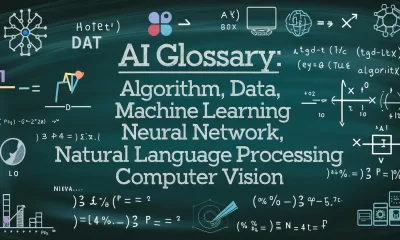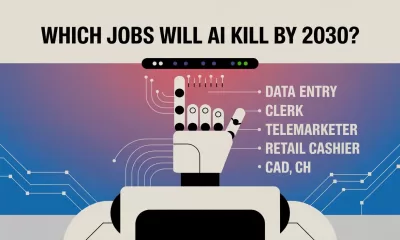Chatbots
Research Made Easy: 6 Steps to Using ChatGPT for Powerful Paper & Presentation Prep
Never spend a second aimlessly scrolling on Google for sources again.
Published
1 year agoon
By
AIinAsia
TL;DR: ChatGPT for Research in Asia
- Use an AI tool such as ChatGPT for Research in Asia, to significantly streamline the process, boosting productivity and efficiency.
- The 6-step guide to using ChatGPT for research includes brainstorming, outlining, sourcing, deep diving into specific aspects, finding examples, and generating citations.
- Fact-checking and critical thinking remain essential when using AI tools like ChatGPT for research purposes.
Harnessing the Power of ChatGPT for Academic and Market Exploration in Asia
Artificial Intelligence (AI) is no longer a futuristic concept but a transformative reality, and ChatGPT is at the forefront of this revolution. While some may view it as a potential usurper of human roles, this AI tool can actually be an invaluable research assistant, enhancing productivity and optimising your research process. Whether you’re a student in Singapore tackling a dissertation or a professional in Tokyo navigating market research, ChatGPT can be your secret weapon for for Research in Asia.
6 Steps to Optimise Your Research with ChatGPT
Step 1: Brainstorming Brilliant Ideas
Struggling with a topic? ChatGPT is your brainstorming companion and AI research assistant! Provide it with a general theme and ask for specific ideas. You can even modify its suggestions to find the perfect angle. For instance,
“I need to write a research paper on ‘Dictating Narrative Throughout History’. Can you suggest some specific topics?”
Step 2: Outlining Your Masterpiece
Once you have a topic, your AI research assistant can help structure your work. Ask for an outline, specifying your assignment details (e.g., page length, primary sources) for a bespoke plan. For example,
“Can you give me an outline for a 15-page research paper on ‘History: the winners control the narrative’ using 5 primary sources?”
Step 3: Sourcing Like a Pro
With your topic and outline set, let ChatGPT assist in gathering resources. Request relevant sources based on your theme. For instance,
“Can you give me sources for a 15-page paper on ‘History: the winners control the narrative’?”
Step 4: Deep Diving into Specific Aspects
Need sources for a particular section? Your ChatGPT research assistant can find relevant references for any subtopic. For example,
“Can you give me sources for the social and intellectual climate when the [insert famous war] press was won and the main public sentiment for the winner, and the loser?”
Step 5: Finding the Perfect Example
To illustrate your point, ChatGPT can unearth relevant historical events. For instance,
“What was a time in history when the narrative from the winners of [insert famous war] backfired on society and had negative impacts?”
Step 6: Generating Citations in a Flash
ChatGPT can create proper citations, eliminating formatting headaches. Provide the source (link or title) and your desired citation style. For example,
“Can you generate a citation for this article in the style used by AIinAsia, including the access date?”
Remember, ChatGPT is a tool, not a substitute for human effort. ChatGPT for Research in Asia. Always fact-check and evaluate the information it provides, and use it to supplement, not replace, your critical thinking and analysis.
As AI tools like ChatGPT continue to evolve, how might the role of human researchers transform in the future? Share your thoughts in the comments below.
You may also like:
- AI Can Now Locate You From Your Photos
- Pivot into an AI job within 6 months!
- Guide: 7 Simple Steps to Teach ChatGPT To Write In Your Own Voice And Style
- Or try the free version of ChatGPT here.
Author
Discover more from AIinASIA
Subscribe to get the latest posts sent to your email.
You may like
-


OpenAI’s New ChatGPT Image Policy: Is AI Moderation Becoming Too Lax?
-


DeepSeek Dilemma: AI Ambitions Collide with South Korean Privacy Safeguards
-


AI Glossary: All the Terms You Need to Know
-


ChatGPT’s New Custom Traits: What It Means for Personalised AI Interaction
-


AI Trends for 2025 from IBM Technology
-


Google’s AI Course for Beginners (in 10 minutes)!
Business
Sam Altman: A ChatGPT Revolution Across 3 Key Industries
ChatGPT revolutionises industries in Asia with increased productivity and innovation.
Published
1 year agoon
January 27, 2024By
AIinAsia
TL;DR:
- A ChatGPT revolution is upon us and transforming coding, education, and healthcare industries with significant productivity gains.
- AI-powered tools in education enhance personalised learning, while healthcare sees benefits in administration and research.
- Embrace ChatGPT as a collaborative tool with caution, as it continues to evolve and improve.
ChatGPT’s Impact on Coding, Education, and Healthcare
ChatGPT, the AI-powered language model developed by OpenAI, is revolutionising industries across the globe, particularly in coding, education, and healthcare. CEO Sam Altman identifies these three sectors as primed for a productivity revolution. Let’s explore how ChatGPT is driving change in these areas and its potential impact on Asia.
Coding at Warp Speed
Altman claims that ChatGPT can triple programmers’ output by assisting with code review, test case generation, and code generation. In a conversation with Bill Gates on the “Unconfuse Me” podcast, Altman stated, “Coding stands out for its potential gains. OpenAI’s GPT-4 is already deployed at scale, significantly accelerating workflows.” However, a 2023 Stanford-Berkeley study indicates a 50% error rate on programming tasks, requiring coders to exercise caution and verify the AI’s work. The ultimate goal is to free up mental resources for creative problem-solving and innovation.
Revolutionising Education
AI systems like ChatGPT enable educators to create personalised learning paths and automate administrative tasks. AI-powered language learning assistance could transform education in Asia, where English proficiency is highly sought after. Bill Gates champions ChatGPT’s role in powering personalised tutoring, saying in a keynote talk at the ASU+GSV Summit, “The AIs will get to that ability to be as good a tutor as any human ever could.” While concerns about AI-facilitated cheating persist, the potential benefits for learners cannot be ignored.
Healing with AI
Although ChatGPT’s clinical application remains limited due to error risks, AI tools can alleviate administrative burdens for doctors, analyze research, and educate patients. Pharmaceutical companies are also leveraging ChatGPT to automate drug discovery and research. The Gates Foundation is committed to using AI for solving healthcare challenges in developing nations, including those in Asia. As Altman noted, “These are the stupidest the models will ever be,” implying that AI capabilities will only continue to improve.
Embracing the Future with Caution and Understanding the ChatGPT Impact
As ChatGPT continues to evolve, it is crucial to approach its integration with critical thinking and caution. By embracing AI as a collaborative tool, we can harness its power to boost productivity, creativity, and impact across various industries in Asia.
Comment and Share on this ChatGPT Revolution
Have you experienced the transformative power of ChatGPT or other AI tools in your industry? Share your stories and subscribe for updates on AI and AGI developments shaping our future.
You may also like:
- Sam Altman: It’ll be powered by Fusion, But Not Quite Skynet
- The Impact of AI on Coding: A Look at Amazon CodeWhisperer
- Masterclass: Crafting Effective ChatGPT Prompts in Healthcare in 2024
- Or read the official blog from Bill Gates on his thought around the AI by tapping here.
Author
Discover more from AIinASIA
Subscribe to get the latest posts sent to your email.
Chatbots
The Quiet Revolution: Asia’s Shift to Custom AI Chatbots
Asia’s AI revolution favours custom chatbots for efficiency and cost-effectiveness, marking a shift from universal AI solutions.
Published
1 year agoon
January 27, 2024By
AIinAsia
TL/DR:
- Asia is increasingly adopting niche AI models over one-size-fits-all solutions for greater efficiency and cost-effectiveness.
- Experts predict a future where specialised AI bots handle different tasks throughout the day.
- OpenAI’s future remains uncertain as hardware advancements and niche models reshape the AI landscape.
Asia’s AI Revolution: Tailored Solutions Over One-Size-Fits-All
In the world of artificial intelligence (AI), OpenAI’s ChatGPT may be the reigning champion. But there’s a quiet revolution is unfolding in Asia, where companies are opting for custom AI chatbots over universal solutions. These task-specific assistants, such as Salesforce’s Einstein, cater to unique business needs, offering enhanced efficiency and cost-effectiveness.
The Rise of Niche AI: A New Dawn for Specialised Bots
Salesforce’s Einstein is a prime example of this shift. Trained on both internal and open-source data, it excels at coding assistance and workflow automation. However, it doesn’t compete with ChatGPT’s creative writing capabilities. This trend reflects a growing belief in Asia: smaller, targeted models provide precise solutions without the resource-intensive demands of giants like GPT-4.
Professor Yoon Kim of MIT supports this view, suggesting that niche AI could create a future where we interact with specialised bots for different tasks throughout the day. Braden Hancock, CTO of Snorkel AI, shares this sentiment, noting that clients, particularly in finance, are embracing niche models for customer service or coding assistance.
OpenAI’s Future: A Tale of Two Scenarios
Despite the rise of niche AI, OpenAI’s future remains intriguing. Amin Ahmad, CEO of Vectera, envisions two possibilities. In one, hardware advancements make GPT-4 universally accessible. In the other, an influx of niche large language models (LLMs) fuels intense competition. This latter scenario could explain OpenAI’s recent push for AI regulations, a potential strategy to maintain its lead in a diversifying market.
Asia’s AI Revolution: A Paradigm Shift in the Industrya
Asia’s embrace of niche AI signifies a paradigm shift in the industry. The region is demonstrating that smaller, specialised models can be as powerful, if not more efficient, than their larger counterparts. While OpenAI’s influence remains significant, Asia’s AI revolution is subtly forging its own path, prioritising practicality, efficiency, and tailored solutions.
Comment and Share:
What’s your take on the shift towards niche AI models? Have you experienced the benefits of custom AI chatbots in your work or daily life? Share your thoughts below and don’t forget to subscribe for updates on AI and AGI developments in Asia.
You may also like:
- How to Use ChatGPT
- Hybrid AI Ecosystems: The Next Wave of Innovation
- 10 Amazing Prompts to Create AI-Powered Phone Wallpapers (with Freebies!)
- Read more about Salesforce Einstein by tapping here.
Author
Discover more from AIinASIA
Subscribe to get the latest posts sent to your email.
Chatbots
OpenAI Slashes Prices and Tackles ‘Lazy’ GPT-4
OpenAI’s price drop and updates to impact AI growth in Asia.
Published
1 year agoon
January 27, 2024By
AIinAsia
TL;DR:
- OpenAI price drop for GPT-3.5 Turbo, making AI more accessible
- GPT-4 Turbo’s ‘laziness’ issue addressed in new update
- Upcoming GPT-4 Turbo with vision and improved moderation tools to boost AI applications,
AI enthusiasts and developers across Asia, rejoice! OpenAI, a leading AI research and development company, has announced a series of updates that will make its advanced technology more affordable and efficient. The spotlight is on the significant price reduction for the GPT-3.5 Turbo model, which powers popular chatbots like ChatGPT.
Price Drop for GPT-3.5 Turbo
Input costs for GPT-3.5 Turbo have been cut by 50%, while output costs have been reduced by 25%. This substantial price drop makes it more feasible for developers and hobbyists to explore text generation and analysis, ultimately pushing the boundaries of AI innovation in Asia.
Addressing GPT-4 Turbo’s ‘Laziness’
OpenAI has tackled an unusual issue with the GPT-4 Turbo model in preview mode. Users noticed that the model, renowned for its code-generation capabilities, sometimes exhibited ‘laziness,’ failing to complete tasks fully. The new 0125 version addresses this issue, ensuring more reliable and thorough results.
GPT-4 Turbo with Vision and Improved Moderation Tools
The AI revolution in Asia is set to gain momentum with the upcoming general release of GPT-4 Turbo with vision. This model combines AI vision capabilities, opening new avenues for AI applications. Additionally, OpenAI has released an improved version of its free moderation API (version 007) to help combat harmful content online.
Quoting OpenAI’s CTO, Mira Murati, “Our goal is to make AI more accessible and ensure its responsible development. These updates reflect our commitment to that mission.”
The Impact on Asia’s AI Landscape
OpenAI’s updates are set to democratise AI, fostering innovation and collaboration across various sectors in Asia. With more affordable and efficient AI tools, the region is poised to witness a surge in AI-driven solutions and applications.
Comment and Share:
How do you plan to leverage OpenAI’s price drop and updated models in your projects? Share your thoughts below and don’t forget to subscribe for more updates on AI and AGI developments in Asia!
You may also like:
- Four AI Technologies Transforming Marketing
- OpenAI’s Game-Changing Updates: Enhanced AI Capabilities and Affordability in Asia
- Real-Time AI Image Generation Creation Now Possible
- Or try out the free version of ChatGPT by tapping here.
Author
Discover more from AIinASIA
Subscribe to get the latest posts sent to your email.

Playbook: How to Use Ideogram.ai (no design skills required!)

AI Career Guide: Land Your Next Job with Our AI Playbook

Will AI Take Your Job—or Supercharge Your Career?
Trending
-

 Life3 weeks ago
Life3 weeks agoWhich Jobs Will AI Kill by 2030? New WEF Report Reveals All
-

 Life2 weeks ago
Life2 weeks agoAI Career Guide: Land Your Next Job with Our AI Playbook
-

 Business2 weeks ago
Business2 weeks agoWill AI Take Your Job—or Supercharge Your Career?
-

 Tools2 weeks ago
Tools2 weeks agoCan AI Videos Really Boost Your Brand’s Authenticity?
-

 Marketing54 minutes ago
Marketing54 minutes agoPlaybook: How to Use Ideogram.ai (no design skills required!)
-

 Business3 weeks ago
Business3 weeks agoThe Three AI Markets Shaping Asia’s Future
-

 Life3 weeks ago
Life3 weeks agoWould You Trust Tesla’s Grok AI More Than Your Friends?



























